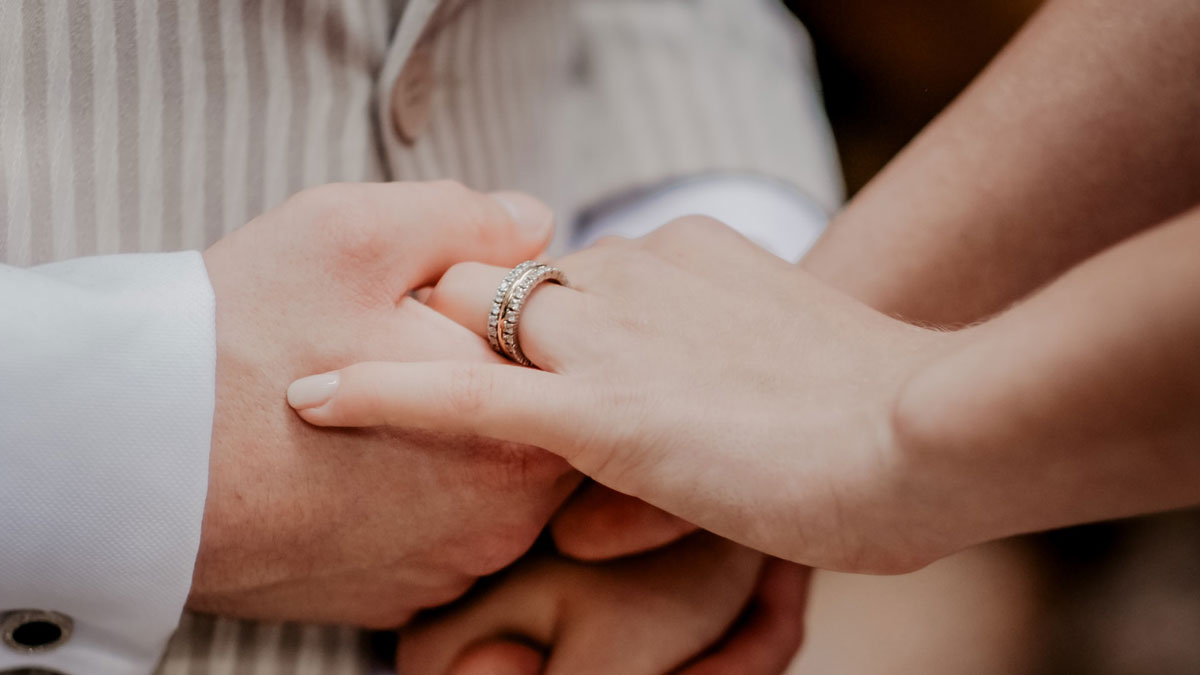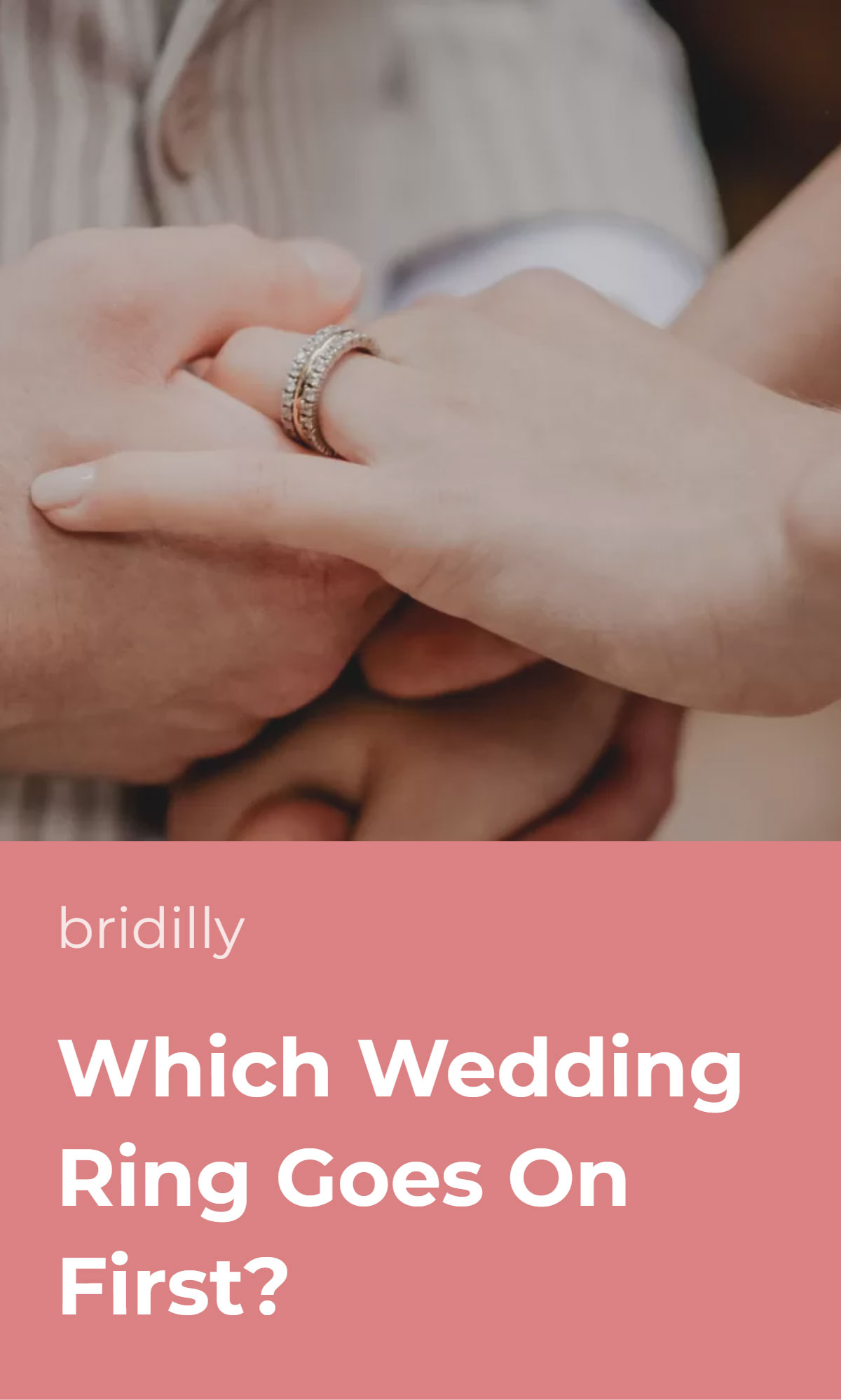Many couples are confused about the entire wedding ceremony process, and which wedding ring goes on first.
Is it the bride’s ring, then the groom’s ring, or vice versa? Does the ring exchange order even matter?
The answer depends on the couple’s attitude to tradition, cultural background, and where the ceremony is held. Wedding traditions constantly change, including the ring exchange customs.
Modern wedding ceremonies don’t have as strict rules as they used to centuries ago. Still, religious ceremonies typically follow certain customs, while civil ceremonies are more democratic.
Thankfully, marriage officiants know that wedding is a nervous event for most couples and strive to help them by giving instructions.
Thus, relax and listen to your officiant. Even if you mess up the order, no one will blame you.
Table of Contents [show]
The Traditional Way
Traditionally, the bride’s ring goes on first, and the groom’s ring afterward. The explanation to why the bride’s ring goes on first may lie in history. The custom of men wearing wedding rings only appeared relatively recently.
Ancient Egyptians, Greeks, and Romans presented wedding rings to their loved ones as a sign of eternal love and devotion.
Although some historical evidence suggests there were exceptions, they didn’t typically wear wedding bands themselves.
In the Middle Ages, men often wore rings to signify wealth and authority but never devotion to their wives.
Arranged marriages were widespread in Europe, being merely a business contract between two families than a celebration of love.
At those times, women’s wedding rings served as a sign of ownership. Men didn’t have to wear them because they had more freedom.
Arranged marriages weren’t common among lower social classes, but poor people couldn’t afford two wedding rings. They had one at most, often none.
Overall, the wedding ceremony until the 12th century was straightforward. All a man had to do was offer a woman to marry him and get her verbal consent. No witnesses or clergymen were required.
Sometimes, a man offered a woman ring along with his proposal, serving as a wedding band. Once she accepted the ring, the couple was considered married.
Simply put, there was no need for the groom’s consent since he had initiated the marriage.
In the 12th century, the Christian church established new wedding ceremony rules, declaring marriage a holy sacrament, and the practice of placing a ring on the bride’s finger became the norm.
The church promoted ring exchange to keep men faithful, but the practice was rare until the last century. During World War ll, men started wearing wedding rings as a reminder about their wives back home.
After the war, civilian men also started wearing wedding rings. However, some historical evidence suggests that Dutch and German men customarily wore wedding rings since the 1870s.
Regardless of who started the tradition of ring exchange, it isn’t a particularly old one. The bottom line is that the bride’s ring goes on first because men historically didn’t wear rings.
Groom’s Ring First
Some couples reverse the wedding ring exchange order, and the bride places the ring on the groom’s finger first. The groom takes the risk first, allowing the bride to change her mind.
This practice is becoming more widespread nowadays, and many wedding officiants promote it. Perhaps, this is because women nowadays have so much more freedom, and reversing the roles has symbolic significance.
When the bride offers a ring to the groom first, she shows that they are equal and marrying him is her free choice.
Does the Order Matter?
Both ring exchange order options are justified, so you may wonder – does the wedding ring exchange order matter? In short, no. The couple is free to decide which custom they like more and who’s the brave one.
Some couples never think about which wedding band goes on first – they simply follow the officiant’s instructions. Typically, the exchange of the rings has the same order as the vow exchange.
Often, it comes down to whoever is less nervous and is ready to talk first. If the bride is willing to tell her vow first, she also paces the ring on the groom’s finger first, and vice versa.
Some wedding officiants ask about the order right during the ceremony knowing that people handle stress differently, and losing voice before vow exchange isn’t uncommon, even for seemingly extraverted people.
Couples who value tradition more often go for the historic option – the bride’s ring first, then the groom’s ring.
On the other hand, couples who believe that rules are made to be broken, and customs should keep up with the times often reverse the roles.
The truth is that modern couples have total freedom of choice regarding their wedding ceremony.
The couple can skip the ring exchange altogether, only have one ring, or place the ring on each other’s fingers simultaneously if they wish to.
However, if you plan to change the traditional wedding ring exchange order, warning the officiant is a good idea to ensure the ceremony goes smoothly and not awkwardly.
You may also want to find out your and your partner’s family’s opinions. If the parents are very traditional, they may not like the idea of reversing the order.
Note that this only applies to a civil ceremony at a courthouse. If you opt for a religious ceremony at a Catholic church, the ring exchange will likely follow the traditional scenario – the bride’s ring first, then the groom’s.
Which Ring Goes First in Islam?
The tradition mentioned above only applies to the western world, but what about other cultures? The wedding ceremony rules in Islam are much stricter. Islam promotes the teaching of marriage without dating.
Because dating is considered a sin, religious Muslim couples don’t undergo the entire engagement process.
And, because the tradition of wearing wedding rings originates in the west, many also consider that it goes against the teaching of Islam.
For this reason, religious Muslim couples don’t wear wedding rings at all. However, less religious couples have adopted the tradition like most of the world. Most importantly, the men’s ring shouldn’t be from gold.
During the wedding ceremony, the Iman of Maulvi first asks for the bride’s consent, then the groom’s. Therefore, the bride’s ring goes on first if the couple decides to wear wedding bands.
Which Ring Goes First in Judaism?
Only the bride receives a ring in Orthodox Jewish tradition, and the groom doesn’t wear one. Logically, this means that the bride’s ring goes on first.
Same as in western history, the tradition represented that the groom acquired the bride as his wife in exchange for the ring, so the ring signified ownership.
However, many modern Jewish couples adopt the western tradition of ring exchange as a sign of mutual respect and love.
Still, even in the modern adaptation, the bride’s ring goes on first, then the groom’s ring, following the officiant’s instructions.
Which Ring Goes First in Other Cultures?
Wedding ceremony traditions around the world are very different, often the opposite of what we’re used to. For instance, in Orthodox Christianity, the bride and groom wear their wedding rings on the right rather than the left hand.
The ring exchange tradition appeared in Orthodox Christianity long before Catholic priests started promoting it. However, the bride and groom don’t place the ring on each other’s fingers – instead, the priest does it.
The priest places a silver ring on the bride’s finger first, then a gold ring on the groom’s finger, and connects their hands, symbolizing the eternal union of newlyweds.
The bride and groom must undergo numerous rituals before the ring exchange in a Hindu wedding ceremony. First, they exchange flower garlands known as marla in a ritual called Varmala.
The bride presents her garland to the groom first; then, the groom gives his to the bride.
Afterward, they receive parental blessings, tie a knot, and the groom presents the bride with a necklace. Finally, the couple exchanges their rings – the groom’s ring goes on first.
Until recently, Protestant wedding ceremonies didn’t involve ring exchange. Only the bride received a ring, the same as in Catholicism. Nowadays, most Protestant couples exchange rings, but the bride’s ring still goes on first.
A Lutheran wedding ceremony is not much different from other Christian ceremonies – the priest blesses the rings, and the couple exchanges them.
The bride’s ring goes on first, but sometimes, the couple exchanges their rings simultaneously.
Scandinavian couples more often choose the modern wedding ring exchange scenario, where the groom’s ring goes on first, followed by the bride’s ring.
Interestingly, many Scandinavian couples even have two engagement rings, and women often make the proposal – perhaps, that’s what true equality is like.
Although the rings always play a significant role, the ring exchange order doesn’t matter in Wiccan weddings. The couple is free to decide who presents the ring first.
Japanese wedding traditions tend to be different from western, but the ring exchange is an exception. Japanese couples also exchange wedding rings during the ceremony – the bride receives hers first.
Chinese couples also observe the ring exchange tradition, and the bride typically receives her ring first.

















No Comments Add one
Leave a Comment